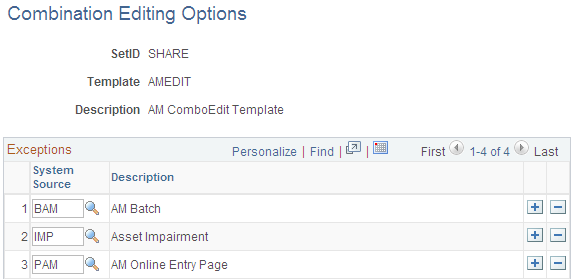Enabling Combination Editing
This topic provides an overview of combination editing and lists the pages used to define combination edit processing for PeopleSoft Asset Management.
|
Page Name |
Definition Name |
Usage |
|---|---|---|
|
BU_BOOK_DEFN_01 |
If the Create Accounting Entries check box is selected, the ChartField Edit Options group box appears. Select to receive a warning message, to reject the transaction or to perform no ChartField combination edits for the business unit and book. |
|
|
AM_CEDT_SSRC |
Select the system source or sources of the processes for which you want to enable ChartField combination editing. |
Asset Management leverages the existing common setup for valid and invalid ChartField combinations and is consistently applied to all transactions that generate accounting entries for General Ledger.
See Understanding ChartField Combination Editing.
ChartField combination editing is applicable for books that are associated to a GL ledger. Set ChartField combination editing options at the business unit/book level. These settings are applied upon saving certain online components, at which time the Combo Edit processor is invoked (FS_COMBO_EDIT). If the ChartField combination fails validation, an additional Combo Edit page appears within the online component that displays the error message. Depending upon the combo edit options settings, the page may be saved with errors, rejected, or bypass combination editing.
Note: As account values are not entered in the asset transactions themselves, it is the fixed asset (FA) accounts that are defined for the transaction type, cost type, category and accounting entry template that are used in validating ChartField combinations.
For batch Asset Management transactions, the process invokes the Combination Editing Options setup. Specify the system sources that are to be excluded from ChartField combination editing validation (generally includes sources wherein ChartField combinations may have already been validated).
This table presents the Asset Management components for which combination editing is available:
|
Event |
Type of Processing |
Components/ Pages/ Processes |
|---|---|---|
|
Add assets. |
Online Batch |
Express Add (ASSET_ENTRY_00) page. Transaction Loader process (AMIF1000). Asset Basic Add (ASSET_GENERAL_01) page. |
|
Adjust, revalue, recategorize, or transfer assets and costs. |
Online Batch |
Cost Adjust/Transfer Asset (COST_BAL) page. Transaction Loader process (AMIF1000). |
|
Retirements and reinstatements. |
Online Batch |
Retire/Reinstate Asset (RETIRE) component. Transaction Loader process (AMIF1000) |
|
Leased assets. |
Online |
Leased Assets, Express Add (LEASE_ENTRY) page. Update Lease Information (LEASE_ENTRY) page. Transfer Operating Lease (LEASE_OPR_TFR) page. |
|
Consolidate and unitize assets. |
Online |
Consolidate Assets (ASSET_CONSOL) page. Unitize Assets (ASSET_UNIT) page. |
|
Copy an asset. |
Online |
Copy Existing Asset (COPY_ASSET) page. |
|
Review financial entries. |
Online |
Review Financial Entries (ASSET_DIST). |
|
Review operating leases. |
Online |
Review Operating Leases (NF_DIST_LN). |
|
Review expense entries. |
Online |
Review Expense Entries (ASSET_NF_DIST). |
|
Impairment, Revaluation, Disposal |
Batch |
Transaction Loader process (AMIF1000) |
|
Update non capitalized costs. |
Batch |
Update Non-capitalized Costs (NON_CAP_COSTS) page. |
Use the Business Unit/Book Definition page (BU_BOOK_DEFN_01) to if the Create Accounting Entries check box is selected, the ChartField Edit Options group box appears.
Select to receive a warning message, to reject the transaction or to perform no ChartField combination edits for the business unit and book.
Navigation:
This example illustrates the fields and controls on the Business Unit/Book Definition Page. You can find definitions for the fields and controls later on this page.

See Business Unit/Book Definition Page.
Warning! Changes to the original ChartField combination editing rules may result in invalid ChartField combinations for subsequent Asset Management processes, such as depreciation. Some transactions such as retirements cannot be done at all (if the Combination Edit option is set to Reject) if you invalidated previously accepted combinations. A similar situation occurs when you deactivate a ChartField that is assigned to an asset. In this case, you would have to reactivate the ChartField and include those combinations again, or set the Combination Edit Option to Warning or No Edits.
Use the Combination Editing Options page (AM_CEDT_SSRC) to select the system source or sources of the processes for which you want to enable ChartField combination editing.
Navigation:
This example illustrates the fields and controls on the Combination Editing Options Page. You can find definitions for the fields and controls later on this page.

Field or Control |
Description |
|---|---|
Template |
The combination editing process uses the record template for structural information to perform ChartField combination edits. The record templates have a unique name that is applicable to a particular PeopleSoft application. |
Exceptions
Field or Control |
Description |
|---|---|
System Source |
Enter the trusted sources that do not need ChartField combination validation. Select the system source code as it appears in the interface tables. |